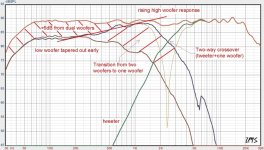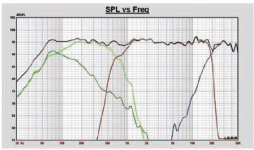I am much more likely to use a separate box for the .5 woofer when there is a great disparity in size between drivers
The speaker that I am building has yet another interesting 2.5 way setup. The Midrange is 6.5" and in a sealed enclosure (16 L), while the 0.5 driver is a 8" driver in a ported larger enclousure. So, you can say the "midrange" got some damped bass response, because the closed box minimizes the cone movement and bass, improving the midrange clarity. I personally think this is a pretty smart design.
I will make a writeup, once I am done with the cabinets. It is Troels Gravesen Discovery 861
I will make a writeup, once I am done with the cabinets. It is Troels Gravesen Discovery 861
There are many three way speakers which use the same "woofer" in a sealed box with filter for the low and high frequencies.I can't think of a 2.5-way that looks "identical" to a 3-way or vice-versa. A 3-way has a woofer, a smaller, dedicated midrange driver and tweeter, while a 2.5-way has two identical midwoofers and a tweeter. They are two different ways of achieving higher efficiency and power handling with respect to a 2-way: the 3-way uses a large woofer which, generally speaking, can't reach high enough frequencies to cross it over directly to a tweeter, because of its frequency response and/or directivity, so a midrange driver is needed; the 2.5-way doubles the woofer area by adding a second midwoofer. Each has its pros and cons, but a couple advantages of a 2.5-way is that you don't need a separate midrange enclosure inside de box (two identical midwoofers can happily share the same enclosure without trouble) so construction is simpler, and that you can have a high efficiency speaker with a rather narrow front panel, which maybe what you want for the particular layout of your listening room and/or for diffraction and/or aesthetic and/or WAF reasons.
Or b&W 3-way, where the midrange has a larger cone than the woofers.
I've also seen a JBL 2.5 way tower with a smaller woofer for the bass-mid and a larger woofer for the bass. Sharing the same cabinet. And the small woofer reached more excursion earlier so I'm not sure that's such a great design
In my experience:
- 2.5-way sounds better at low/moderate volumes. Better mid-range coherence, improved vocal realism & slightly better imaging.
- 3-way sounds better at loud volumes. Less intermodulation distortion affecting midrange and better power handling in general.
The original idea behind 2.5-way was basically economical, using the same smaller midwoofer twice, often in a W-T-W vertical arrangement to create a nice narrow form-factor with eye-pleasing symmetry. Sometimes also in horizontal arrangement, for "sound-bar" type center speakers.
But the idea of simply rolling off one woofer at a lower frequency than the other is not without pitfalls. A technically correct 2.5-way is basically an extended 3-way with the midrange also covering bass range, with the important detail that this reproduced bass range has the same phase response as the dedicated woofer. That makes the crossover basically as complex than that of a 3-way because you need an extra allpass on the midwoofer for that.
This goes against cost savings and therefore the crossover is often chosen as that of a simple 2-way with an simple 1st order lowpass (coil) in front of the woofer, which makes the ways run non-coherent, phase-wise (and resulting in amplitude aberrations as well), often leading to directivity problems.
Further, the need for separate compartments for woofer and midwoofer is often neglected as well.
Bottom line: A proper 2.5-way is not that much different from a proper 3-way, both in terms of effort and results. Of course, each concept has its own strengths and drawbacks with. It all depends on the skills of the designer and the quality of the execution.
But the simple cheating 2.5-way I would consider inferior to any of the above.
But the idea of simply rolling off one woofer at a lower frequency than the other is not without pitfalls. A technically correct 2.5-way is basically an extended 3-way with the midrange also covering bass range, with the important detail that this reproduced bass range has the same phase response as the dedicated woofer. That makes the crossover basically as complex than that of a 3-way because you need an extra allpass on the midwoofer for that.
This goes against cost savings and therefore the crossover is often chosen as that of a simple 2-way with an simple 1st order lowpass (coil) in front of the woofer, which makes the ways run non-coherent, phase-wise (and resulting in amplitude aberrations as well), often leading to directivity problems.
Further, the need for separate compartments for woofer and midwoofer is often neglected as well.
Bottom line: A proper 2.5-way is not that much different from a proper 3-way, both in terms of effort and results. Of course, each concept has its own strengths and drawbacks with. It all depends on the skills of the designer and the quality of the execution.
But the simple cheating 2.5-way I would consider inferior to any of the above.
Is this really necessary? The difference range should be mostly absorbed by the stuffing.the need for separate compartments for woofer and midwoofer is often neglected as well.
It depends, I'd say. Sometimes stuffing alone will suffice, sometimes it won't. I generalized a bit too much ;-)Is this really necessary? The difference range should be mostly absorbed by the stuffing.
So, the .5 driver help increase sensitivity by adding output below the baffle stepped instead of cutting output brom MW driver above the step..............An extra midwoofer below the one next to the tweeter helps address the inadequate low frequency output by providing +6 dB to counter the -6dB baffle step loss. This requires a low pass filter on the lower midwoofer to match the baffle step loss.........
But what about lobing and combing?
Given that the LP filtrering of the 0.5 is a coil producing 6dB/Octave and the step setting in at about 650hz would this not also make low x-over point for the tweeter and/or low x-over slopes poor choises?
For example a 2200hz 12dB/octave highpass for tweeter and 650hz 6dB lowpass would both produce significant output at 1100 Hz.
In a typical TMM configuration the distance between the 0.5 and tweeter would be lager than ideal.
Can this effect be truely be disregarded or am I missing something?
Yes, this can be an issue. I've seen 2.5-way W-T-W speakers with horrible lobing issues because they were not-well designed. Large 7in woofer/midwoofer, W-T-W arrangement, simple .5 way with 6dB slope at a rather high'ish frequency==> the two woofers fought each other big time, pronounced and very asymmetrical horizontal lobing patterns in the delicate lower midrange. With phase coherence between woofer and midwoofer the pattern would have been at least symmetrical but that would not suffice to make it a great speaker.But what about lobing and combing?
IME, the upper crossover point, midwoofer to tweeter, is less of a problem. Of course the added woofer can add some extra dirt, depending on design.
So, the .5 driver help increase sensitivity by adding output below the baffle stepped instead of cutting output brom MW driver above the step.
?

Just a conceptual sketch.
Given that the LP filtrering of the 0.5 is a coil producing 6dB/Octave and the step setting in at about 650hz would this not also make low x-over point for the tweeter and/or low x-over slopes poor choises?

Sill a first order LP, does not mean there won't be more then one induxtor in the XO, and a 6db/oct. acoustic slope. JBL DD66000 for reference.
Last edited:
Definitely experienced this firsthand with my 2.5 way MTM. I played A LOT with the crossover to get both woofers and tweeters to all lign up in phase across the freq spectrum (no more than 30deg sep), even using an all-pass filter on the tweeter for the last bit of phase correction to pull the tweeter into alignment.I've seen 2.5-way W-T-W speakers with horrible lobing issues because they were not-well designed. Large 7in woofer/midwoofer, W-T-W arrangement, simple .5 way with 6dB slope at a rather high'ish frequency
It sounds best with the second (bottom) woofer relegated to baffle step boost. Basically just a 2 way with low end support. It took a lot of correcting to get it right, and some designs that modeled well did not sound right when listening.
AND i think it is absolutely critical to use midbass drivers with relatively smooth natural responses. Any peaks in the upper registers will be doubly amplified. The Satori MW-16P is nice and easy in this design. I wouldn't dare try it with my SB17CRCs due to that 4000Hz breakup peak.
Usually the ideal is a woofer with a rising response like the picture i added above.AND i think it is absolutely critical to use midbass drivers with relatively smooth natural responses.
JBL's engineers were very selective when it comes to the drivers response and EBP, for they're large commercial 2,5 way systems.
Adviced again using 2234/2235's etc for the tasks, as they are too linear in the pass band.
If you look through they're big systems with 2,5 way config you will find that the drivers have a EBP 90-105 somewhere and a rising response.
But a midbass with a flat response measured on an infinite baffle (half space, like on a spec sheet) will look exactly like your plot above when measured on a normal / narrow baffle away from a wall (full space). So I think we are saying the same thing?Usually the ideal is a woofer with a rising response like the picture i added above.
- Home
- Loudspeakers
- Multi-Way
- 2.5 ways versus 3 ways